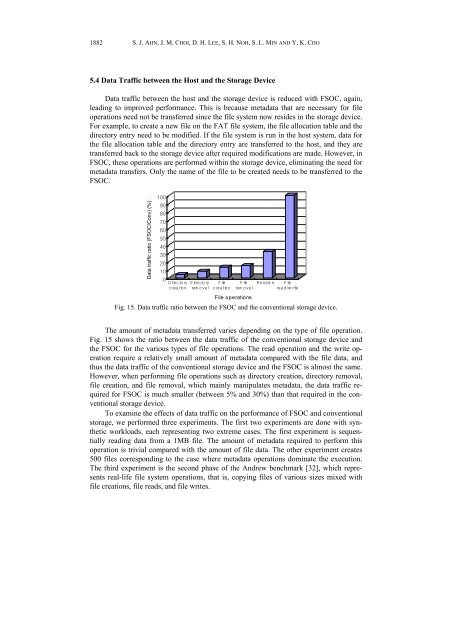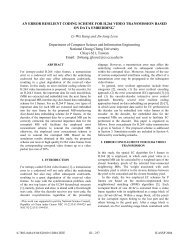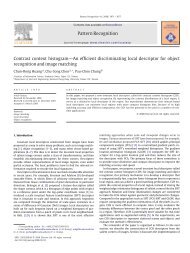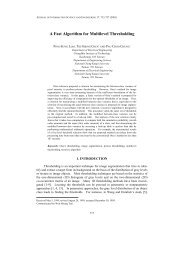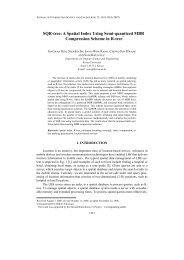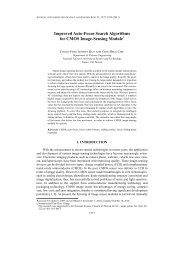Design, Implementation, and Performance Evaluation of Flash ...
Design, Implementation, and Performance Evaluation of Flash ...
Design, Implementation, and Performance Evaluation of Flash ...
You also want an ePaper? Increase the reach of your titles
YUMPU automatically turns print PDFs into web optimized ePapers that Google loves.
1882<br />
S. J. AHN, J. M. CHOI, D. H. LEE, S. H. NOH, S. L. MIN AND Y. K. CHO<br />
5.4 Data Traffic between the Host <strong>and</strong> the Storage Device<br />
Data traffic between the host <strong>and</strong> the storage device is reduced with FSOC, again,<br />
leading to improved performance. This is because metadata that are necessary for file<br />
operations need not be transferred since the file system now resides in the storage device.<br />
For example, to create a new file on the FAT file system, the file allocation table <strong>and</strong> the<br />
directory entry need to be modified. If the file system is run in the host system, data for<br />
the file allocation table <strong>and</strong> the directory entry are transferred to the host, <strong>and</strong> they are<br />
transferred back to the storage device after required modifications are made. However, in<br />
FSOC, these operations are performed within the storage device, eliminating the need for<br />
metadata transfers. Only the name <strong>of</strong> the file to be created needs to be transferred to the<br />
FSOC.<br />
Data traffic ratio (FSOC/Conv) (%) .<br />
100<br />
90<br />
80<br />
70<br />
60<br />
50<br />
40<br />
30<br />
20<br />
10<br />
0<br />
Directory<br />
creation<br />
Directory<br />
re m o v a l<br />
File<br />
creation<br />
File<br />
re m o v a l<br />
File operations<br />
Renam e File<br />
read/w rite<br />
Fig. 15. Data traffic ratio between the FSOC <strong>and</strong> the conventional storage device.<br />
The amount <strong>of</strong> metadata transferred varies depending on the type <strong>of</strong> file operation.<br />
Fig. 15 shows the ratio between the data traffic <strong>of</strong> the conventional storage device <strong>and</strong><br />
the FSOC for the various types <strong>of</strong> file operations. The read operation <strong>and</strong> the write operation<br />
require a relatively small amount <strong>of</strong> metadata compared with the file data, <strong>and</strong><br />
thus the data traffic <strong>of</strong> the conventional storage device <strong>and</strong> the FSOC is almost the same.<br />
However, when performing file operations such as directory creation, directory removal,<br />
file creation, <strong>and</strong> file removal, which mainly manipulates metadata, the data traffic required<br />
for FSOC is much smaller (between 5% <strong>and</strong> 30%) than that required in the conventional<br />
storage device.<br />
To examine the effects <strong>of</strong> data traffic on the performance <strong>of</strong> FSOC <strong>and</strong> conventional<br />
storage, we performed three experiments. The first two experiments are done with synthetic<br />
workloads, each representing two extreme cases. The first experiment is sequentially<br />
reading data from a 1MB file. The amount <strong>of</strong> metadata required to perform this<br />
operation is trivial compared with the amount <strong>of</strong> file data. The other experiment creates<br />
500 files corresponding to the case where metadata operations dominate the execution.<br />
The third experiment is the second phase <strong>of</strong> the Andrew benchmark [32], which represents<br />
real-life file system operations, that is, copying files <strong>of</strong> various sizes mixed with<br />
file creations, file reads, <strong>and</strong> file writes.


